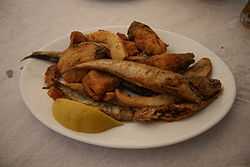
Pescaíto frito.
Pescado frito (literally, "fried fish"), or Pescaíto frito (Andalusian dialect), is a traditional dish from the Southern coasts of Spain, typical in Andalusia, but also found in Catalonia, Valencia, the Canary Islands and the Balearic Islands. It is also consumed as a delicacy in inland Spain, being very common in the inland Andalusian provinces of Seville and Cordoba. It is also very common throughout the Mediterranean Sea, Provence (France), Roussillon (France) and in the coastal regions of Italy (where the most common variant using salt cod fillets is known as filetto di baccalà) and Greece. It was also eaten by the Romans in ancient Rome.
It is made by coating the fish (blue or white fish) in flour and deep fried in olive oil then sprinkled with salt as the only seasoning. It is usually served hot, freshly fried, and can be eaten as an appetizer (for example with a beer or wine), or main course. Usually, it is served with fresh lemon, which is squeezed over the fish or occasionally in "escabeche" (a vinegar marinade/souse).
It is also a traditional Shabbat fish dish (usually cod) originating amongst the 16th century Andalusian Jews of Spain and Portugal.[1] The deep-frying of the fish in vegetable oil makes it crisp and light even when eaten cold, and it is a favourite dish of the late breakfast or lunch after synagogue services on Saturday morning.
There is a general belief that pescado frito was possibly an inspiration for the English fish and chips.[1]
References
- ↑ 1.0 1.1 Marks, Gil (1999). The world of Jewish cooking : more than 500 traditional recipes from Alsace to Yemen. Simon & Schuster. ISBN 0-684-83559-2.
See also
|
|---|
| | True cod | | |
|---|
| | Cod-like | |
|---|
| | Other cod | |
|---|
| | True pollock | |
|---|
| | Pollock-like | |
|---|
| | Fisheries | |
|---|
| | Food | |
|---|
| | Other topics | |
|---|
|
|
|---|
| | History | | |
|---|
| | Language | |
|---|
| | Sports | |
|---|
| | Cuisine | |
|---|
| | Musical instruments | |
|---|
| | Typical music | |
|---|
| | Traditions and feasts | |
|---|
| | Music festivals | |
|---|
|
Category |
|


